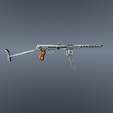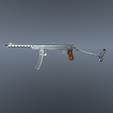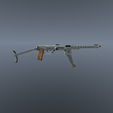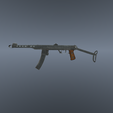You can obtain two types of weapons, which are designed in different versions
The PPS (Russian: ППС – "Пистолет-пулемёт Судаева" or "Pistolet-pulemyot Sudayeva", in English: "Sudayev's submachine-gun") is a family of Soviet submachine guns chambered in 7.62×25mm Tokarev, developed by Alexei Sudayev as a low-cost personal defense weapon for reconnaissance units, vehicle crews and support service personnel.[1]
The PPS and its variants were used extensively by the Red Army during World War II and were later adopted by the armed forces of several countries of the former Warsaw Pact as well as its many African and Asian allies.
History
The PPS was created in response to a Red Army requirement for a compact and lightweight weapon with similar accuracy and projectile energy to the Soviet PPSh-41 submachine gun widely deployed at the time, with reduced rate of fire, produced at lower material cost and requiring fewer man-hours, particularly skilled labour.[1]
Sudayev was ordered by the State Commission for Armaments to perfect for large-scale production the sub-machine gun design of Lieutenant I.K. Bezruchko-Vysotsky from the Dzerzhinsky Artillery Academy, who had created two prototypes in 1942; the second of these was the basis of Sudayev's gun.[2]
During design, emphasis was placed on simplifying production and eliminating most machining operations; most of the weapon's parts were sheet-steel stamped. These measures reduced the number of machined components to a bare minimum, cutting down machining time by more than half, to 2.7 hours of machining instead of 7.3 hours for the PPSh-41. There were also savings of over 50% in raw steel usage, down to 6.2 kg instead of 13.9 kg, and fewer workers were required to manufacture and assemble the parts. Thanks to the improvements in production efficiency, the Soviet planners estimated that the new gun would have allowed an increase in monthly submachine gun output from 135,000 units to 350,000 weapons.[3]
Prototypes were field tested between 26 April and 12 May 1942; the evaluation commission's report was largely favorable, but still proposed some minor improvements mostly aimed at strengthening the gun's structure.[2] By July, Shpagin had finished his own improved model (PPSh-2), and it was pitted in field trials against the PPS, which was found superior in most respects: accuracy, reliability, maneuverability.4.[5] On July 28, 1942, GAU head Nikolai Yakovlev and his aide Ivan Novikov presented Sudayev's gun to the State Defense Committee for approval.[3] The firearm was accepted into service as the PPS-42 (Russian: Пистолет-пулемёт Судаева—ППС or Pistolet Pulemyot Sudayeva model of 1942).[1] The weapon was put into small-scale production during the Siege of Leningrad; mass production did not commence until early 1943 at the Sestroretsk Arsenal (over 45,000 weapons were produced before being replaced by the improved PPS-43).[1] The factory in charge for the pilot production starting in December 1942 was the Sestroretsk Tool Factory [ru]. The first series guns were presented for personal inspection to Andrei Zhdanov and Leonid Govorov in the same month. The full-scale production began in 1943, and the official count of PPS-42 guns produced was 46,572. Most were used during the military trials by the soldiers of the Leningrad Front.[3] The military trials officially took place between January and April 1943.[
I have set them to a 1:35/1:72 ratio for easy printing, and the size comes from the data provided by the encyclopedia. You can adjust its size to any place by yourself.
Note: If using the model for 3D printing, model repairs may be needed.


























